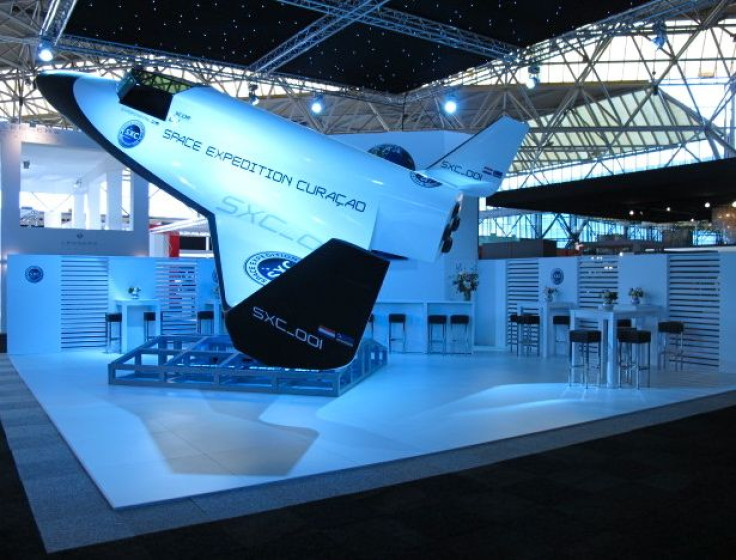The Future Of Space Tourism After The Virgin Galactic Accident

After the Virgin Galactic accident Friday that killed test pilot Michael Alsbury and seriously injured the other pilot, the future of space tourism clearly is in question. Virgin Galactic and its founder, Sir Richard Branson, have been at the forefront of the burgeoning business, but they are not the only company to offer exclusive trips to space. The main advantage Virgin Galactic has over competitors, such as XCOR Space Expeditions, is that it has tested the craft, not just scaled models, that are intended to be used for the trip.
A ticket aboard Virgin Galactic's SpaceShipTwo costs $250,000, and about 700 people have signed up for a flight, including Justin Bieber, Tom Hanks and Angelina Jolie. "SpaceShipTwo, Virgin Galactic’s primary space vehicle, is designed to reach an altitude that exceeds NASA’s definition of space and earns our customers official astronaut status. Passengers will experience the unique thrills of space flight, enjoying the opportunity to leave their seats to float in zero-gravity for several minutes. Looking out 12 large windows, passengers will take in astounding views of space and of the Earth below, stretching approximately 1,000 miles in every direction," reads Virgin Galactic's description of the experience. All passengers would go through three days of training ahead of the flight. Prior to Friday's accident, Virgin Galactic was planning to launch flights in 2015.

California-based XCOR Space Expeditions offers a similar experience 103 kilometers (338,000 feet) above the Earth's surface, starting at $95,000. XCOR has two spacecraft, Lynx Mark I and Lynx Mark II, which will transport space tourists 63 km and 103 km, respectively, above Earth. Flights would take place from either Curacao in the Caribbean or Mojave in the California desert.
The Lynx Mark II will transport space tourists above the 100 km limit of space that makes one an astronaut, according to the U.S. definition, for a cost of $100,000. Every participant would take an astronaut academics course and training prior to flight. The flight begins from a horizontal takeoff followed by a powered ascent before engines are turned off 192,000 feet above Earth. Passengers will experience weightlessness when they reach apogee. Upon re-entry, newly minted astronauts will experience 4g's of force. The trip lasts around 60 minutes. The first trips into space are tentatively planned for 2015.
"The Lynx carries only two people; the pilot-astronaut and you, the space flight participant, in the right seat. You are in the best seat, up front with all the action, watching every move of the pilot. You are truly part of the mission, not just cargo," reads XCOR's description of the Lynx Mark II.
The Lynx Mark I offers a near-space, 61 km, flight at a cost of $150,00 for the first 20 passengers, tentatively scheduled for the second half of 2014, and $95,000 for passengers after 2014. The flight lasts 45 minutes. Other benefits for space tourists include lodging at a luxury hotel, an award ceremony, flight suit with badges, and photos and video of the flight.
While not quite an adventure into space, World View is offering a four- to six-hour flight high above Earth, reaching a height of 100,000 feet, for $75,000. A high-altitude balloon will carry a capsule, capable of carrying six passengers, into the atmosphere. World View has already completed scaled test flights and the spacecraft was determined to fall under "Commercial Space Flight" by the Federal Aviation Administration, giving the company the go-ahead for additional tests. The company expects to launch its first flight in 2016.
For space tourists with serious money who can't wait until 2015 or later, Space Adventures brokers packages with Russia for a ride aboard the Soyuz TMA-M. Options include a trip to the International Space Station, a trip around the moon and even a spacewalk with a cosmonaut. (Only the first option has ever happened.) Richard Garriott, developer of the Ultima computer game series, booked his own flight to space at a cost of $30 million in 2008.
The company will also offer a suborbital spaceflight package in the near future.
If those options are too expensive, thrill-seekers can experience weightlessness on Earth aboard Zero-G, a modified Boeing 727 colloquially known as the "vomit comet."
Space tourism remains out of reach for the 99.9 percent, and following the Virgin Galactic accident, many are questioning the venture. Companies are working toward a viable business model, selling tickets to space, but any potential benefit to humanity is minimal at best, argues Wired's Adam Rogers. Rogers calls the Virgin Galactic SpaceShipTwo "the aerospace version of beluga caviar."
Space tourism is different from Elon Musk's SpaceX venture, which designs rockets and technology to bring manned space missions back to the United States. SpaceX has contracts with NASA, has launched commercial communication satellites, and the only passengers aboard any future manned craft will be NASA astronauts.
"When various corporate representatives eulogize those two pilots as pioneers who were helping to cross the Final Frontier, that should make you angry. That pilot died not for space but for a luxury service provider. His death doesn’t get us closer to Mars; it keeps rich people further away from weightlessness and a beautiful view," Wired's Rogers writes.
© Copyright IBTimes 2024. All rights reserved.












